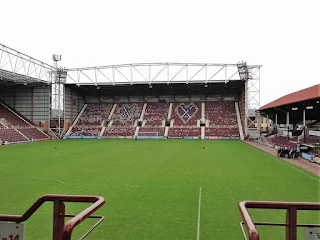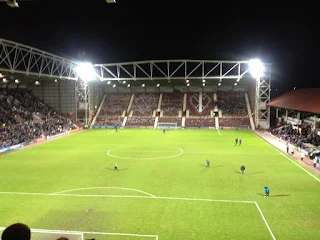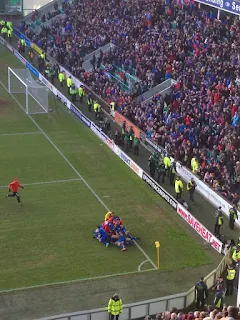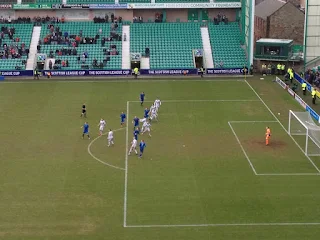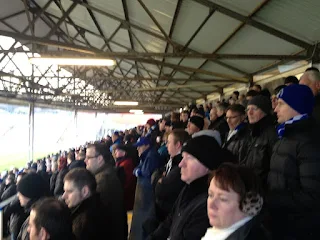Hearts were crowned league champions in 1894-95, going on to win the Cup the following year, this time with a 3-1 win over their biggest rivals, Hibernian (Hibs), at St Bernard's Logie Green home ground in Edinburgh in the only final to have been staged outside Glasgow.
| Tynecastle before redevelopment Image taken from the internet |
The club went forty-eight years without a major honour, but under manager Tommy Walker, success came in droves. The League Cup was lifted in 1954-55 as Motherwell were defeated 4-2. In 1955-56, Celtic were beaten 3-1 in the Scottish Cup Final as an Alfie Conn goal was added to by a brace from Ian Crawford in front of 132,840 fans at Hampden.
Hearts became champions of Scotland for a third time in 1957-58 as forwards Jimmy Wardhaugh and Jimmy Murray bagged the goals. The following season saw another League Cup triumph as Partick Thistle were hammered 5-1 before the trophy was retained with a 2-1 win against Third Lanark.
Later in the 1959-60 season, Walker’s side lifted the First Division title with players such as Willie Bauld, John Cumming, Alex Young and Dave Mackay contributing to the success before several moved on to further their careers. Hearts won another League Cup in 1962-63 as a solitary Norrie Davidson goal was enough to see off Kilmarnock, twelve months after losing the final after a replay to Rangers.
In 1964-64, the Jam Tarts lost the final game of the season 2-0 against Kilmarnock to miss out on the title on goal average. The team went into decline for several years as John Harvey took over as manager in 1966, leading the side to the 1966-67 Scottish Cup final, where they went down 3-1 to Dunfermline Athletic, before Bobby Seith was appointed in 1970.
Some joy was spread with the performances of Donald Ford, Jim Cruickshank and Drew Busby before John Hagart took over as manager in 1974. The Jambos were placed in the Scottish Premier League upon its introduction for the 1975-76 season, with the team defeated 3-1 in the Scottish Cup final against Rangers.
Former Scotland boss Willie Ormond took over at Tynecastle after Hearts were relegated in 1976-77, taking the team straight back up twelve months later as Division One runners-up. However, the step up proved too steep, as the team was relegated after just one season.
The First Division title was secured in 1979-80 before the managerial reins were passed on to Bobby Moncur. His team finished bottom of the Premier Division to go straight back down before Alex MacDonald came in as manager after a short spell from Tony Ford, with Wallace Mercer buying the club after the previous board resigned.
Promotion was secured as runners-up in 1982-83 before fifth place in the Premier Division the following season. In 1985-86, Hearts were seven minutes from being crowned league champions once more as they only needed a draw from their final game, but two Albert Kidd goals for Dundee and a heavy Celtic win at St Mirren meant heartbreak for all at Tynecastle.
Part of the revival was inspired by John Robertson on his way during the first of two spells to become the club's time record scorer. MacDonald was joined by Sandy Jardine from 1985-86 when Hearts lost 3-0 to Aberdeen in the Scottish Cup final and 1987-88, when the team ended as league runners-up, before taking sole control once again.
The team, including such favourites as Henry Smith, Tosh McKinlay, Dave McPherson, Neil Berry, Craig Levein and Eamonn Bannon, defeated Bayern München 1-0 in the home leg of their UEFA Cup tie before eventually going out thanks to a goal from Iain Ferguson, which can be enjoyed at a packed Tynecastle by clicking here.
Joe Jordan was appointed as manager in September 1990 as Mercer unveiled a plan to merge Hearts and Hibs to try and break the Glasgow old firm monopoly, before being blocked in his attempts by angry shareholders who refused the deal.
Hearts ended as Premier Division runners-up in 1991-92 before beating Slavia Praha in the UEFA Cup the following season, with Sandy Clark taking over as manager in May 1993, with Mercer selling the club a year later, and Tommy McLean took over as manager before being replaced by Jim Jefferies in August 1995.
He led the side to the final of the Scottish Cup in his first season, which ended in a 5-1 defeat to Rangers before going down 4-3 to the same opponents in the League Cup final of 1996-97. However, the Jambos gained revenge in 1997-98 as goals from Colin Cameron and Stéphane Adam were enough to defeat Rangers 2-1 in the Scottish Cup final.
The team ended the 1999-00 season in third place in the Premier League before former player Craig Levein came in as manager. His side ended third in the league in 2002-03 and 2003-04 before he was replaced by former playing legend John Robertson. At the same time, the club CEO of the time, Chris Robinson, announced that Tynecastle was not fit for purpose and that the ground needed to be sold to pay off the club's debts.
Hearts would move into Murrayfield, despite Tynecastle having been redeveloped ten years previously. The move was blocked, helped by a campaign called Save Our Hearts. In August of the same year, the Russian-Lithuanian multi-millionaire Vladimir Romanov entered into talks to buy the club.
Romanov made himself immediately popular by stating that the club could become viable by remaining at Tynecastle. He bought up shares from Robinson and other major shareholders, although his manner of controlling the debts caused concern as they were moved from their previous banks into institutions owned by Romanov.
George Burley was the first manager of the new era, and his side won their first eight games before Romanov shocked the football world by sacking him! Graham Rix would be the first of many short-term appointments before he was replaced by Valdas Ivanauskas.
Hearts won the 2005-06 Scottish Cup after defeating Gretna on penalties, with Steven Pressley captaining the side. Romanov sacked a respected CEO, which led to an advisor's resignation. He replaced them both with his son, Roman Romanov. Several players came in on loan from FBK Kaunas of Lithuania, which Romanov also owned.
Anatoliy Korobochka came in as manager in July 2007, with Andrius Velicka putting away the goals before Stephen Frail took charge of the team from January 2008, before Csaba László arrived in July 2008, leading his side to third place before being replaced by Jefferies for a second spell in January 2010.
Financial problems continued to blight the club despite regular appearances in European competition. Hearts finished third in the league in 2010-11, but by the following November, the club was put up for sale as the players' wages weren't paid. Eventually, after several threats, the players under manager Paulo Sérgio received their remunerations.
The setbacks failed to dampen the spirit of the squad, who went on to win the Scottish Cup in 2011-12 with a 5-1 thumping of bitter rivals Hibs at Hampden Park with goals from Darren Barr, Danny Grainger, Ryan McGowan and two goals from consistent fans' favourite Rudi Skácel.
Sérgio rejected a new contract, so former coach John McGlynn was recruited from Raith Rovers with a strict budget and orders to bring through the youth players. Again, the club were hit with transfer sanctions for the first part of the 2012-13 season. In November 2012, Hearts were issued with a winding-up order by the Court of Session in Edinburgh for failing to pay an outstanding tax bill.
It was agreed to pay the bill in two instalments as a new share issue was launched. The team reached the League Cup final in 2012-13 when Hearts went down 3-2 to St Mirren shortly after Gary Locke had taken over as manager, before fans were asked to help save the club as it announced that it would look towards supporter ownership in 2013.
The clubs’ future was in real doubt throughout the summer of 2013 as they entered administration and were deducted fifteen points going into the 2013-14 season. All players were put up for sale as a buyer was desperately sought. ‘The Foundation of Hearts’ supporters group arranged a CVA deal with the club's creditors, while the point deduction proved too much to overcome as Hearts were relegated.
In May 2014, Bidco 1874, fronted by Ann Budge, took control of the club to stabilise finances before handing Hearts over to the Foundation of Hearts. Former full-back Robbie Neilson was appointed manager in May 2014 before exiting administration a month later. The team won the Championship, including Rangers and Hibernian by nineteen points, as Género Zeefuik, James Keatings and Jamie Walker all scored regularly.
Alim Öztürk captained the side to third place in 2015-16 with Juanma ending as top scorer. Neilson departed for MK Dons in December 2016 to be replaced by Ian Cathro before Levein returned for a second spell at the helm in August 2017, with Stephen Naismith’s experience proving valuable in midfield.
Tynecastle was modernised further when the old Main Stand was demolished in 2017 and replaced with a new structure. Hearts finished in sixth in 2018-19 before a shocking start to the 2019-20 campaign saw Levein replaced by Daniel Stendel. The team were bottom of the table when the outbreak of Coronavirus halted proceedings.
Clubs voted to end the season with placings standing at the time, including promotion and relegation. Hearts were demoted and threatened legal action against the SPFL before Neilson was coaxed away from Dundee United to take up the manager's seat. He led the side back to the Premiership as Championship winners in 2020-21, with Liam Boyce scoring the goals.
The team also reached the Scottish Cup final, losing to Rangers, while a third-place finish followed in the top-flight in 2021-22, which was repeated in 2023-24 under manager Steven Naismith. Neil Critchley came in as team boss in October 2024, lasting until the following April, when Derek McInnes was given the job.
Heart of Midlothian FC will play in the Scottish Premiership in the 2025-26 season.
My visits
Tuesday 29th January 2013
As I was only a mile or so away from Tynecastle after visiting several clubs and their grounds around Edinburgh, I decided that it would be a good idea to go to the ground and to purchase tickets for Dad and me for the match the following evening.
I jumped off the bus and went behind the Main Stand, where I saw a gate open with steps leading up to a stand. I went inside and took some photos while taking in the surroundings, as a group of youngsters were by the players' tunnel as they were given a tour.
After taking a few photos, I returned to the ticket office and megastore, where I paid £24 for myself and £18 for Dad for the next day's game. Satisfied with my work, I jumped on a bus to Haymarket, where I was to catch a train to Linlithgow to tick off another couple of non-league venues.
Heart of Midlothian 1 Dundee 0 (Wednesday 30th January 2013) Scottish Premier League (att: 11.284)
Not for the first time, Dad and I had done a marathon walk in a city. This time we just about covered both Edinburgh's old and new towns, as well as a walk through Leith to Ocean Terminal, before going back to our hotel for a much-needed rest before the evening's entertainment. Amazingly, a short nap had revived us as we walked to the Standing Order on George Street for some food.
We quickly realised why Dundee were adrift at the bottom of the table. They were not very good and looked more than happy to leave town with a point as they continually got behind the ball and only occasionally crossed the halfway line. Hearts played some nice stuff, but they were not deliberate enough. Many a time, they had a shooting opportunity and swung in a cross, yet they often looked for one or two passes too many.
Hearts had a couple of loan signings from Liverpool after their transfer embargo had been lifted: Michael Ngoo and Danny Wilson. We only realised this on later reading the programme and then had a good laugh as Mr Ngoo, while very capable of holding the ball up and bringing others into play, also looked incapable of shooting except in the exact direction he was facing.



